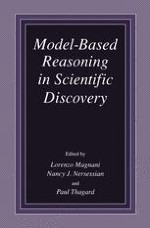1999 | OriginalPaper | Chapter
Abduction and Geometrical Analysis. Notes on Charles S. Peirce and Edgar Allan Poe
Author : Ilkka Niiniluoto
Published in: Model-Based Reasoning in Scientific Discovery
Publisher: Springer US
Included in: Professional Book Archive
Activate our intelligent search to find suitable subject content or patents.
Select sections of text to find matching patents with Artificial Intelligence. powered by
Select sections of text to find additional relevant content using AI-assisted search. powered by
The method of analysis and synthesis in Greek geometry is perhaps the most significant key idea in the history of heuristic reasoning. In theoretical analysis, reasoning goes backward from a theorem to the axioms from which it deductively follows. In problematical analysis, the desired thing is supposed to be given (this defines the so-called “model figure”), and then the reasoning again goes backward looking for possible constructions from which the sought thing results. This paper states that Charles S. Peirce’s description of abduction, as a retroductive inference of a cause from its effects, is an instance of the propositional interpretation of analysis. What Jaakko Hintikka calls the “analysis of figures” view of problematical analysis is illustrated by detective stories of Edgar Allan Poe. The same idea is repeated in Poe’s essay “Philosophy of Composition” where he tells that he wrote his poem The Raven (1845) analytically by starting at the end.
